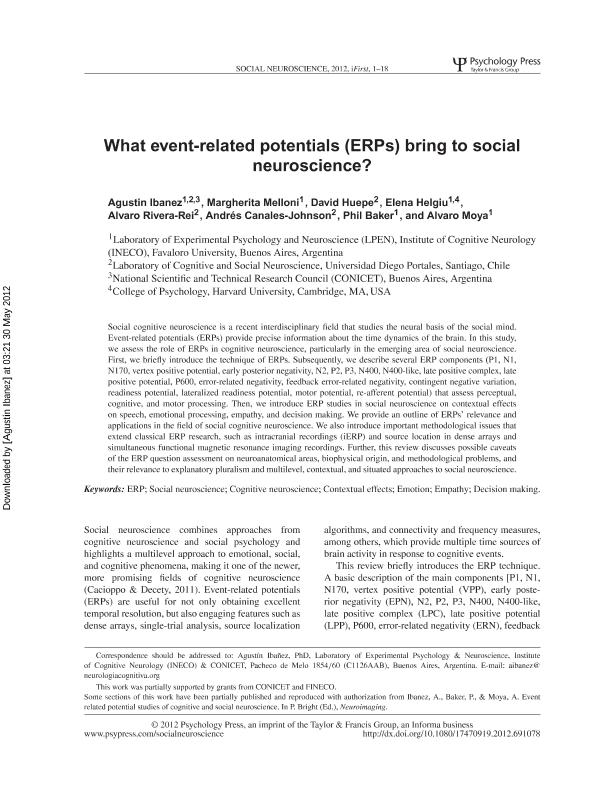Mostrar el registro sencillo del ítem
dc.contributor.author
Ibañez, Agustin Mariano

dc.contributor.author
Melloni, Margherita

dc.contributor.author
Huepe, David
dc.contributor.author
Helgiu, Elena
dc.contributor.author
Rivera Rei, Alvaro
dc.contributor.author
Canales Johnson, Andrés
dc.contributor.author
Baker, Phil
dc.contributor.author
Moya, Alvaro
dc.date.available
2023-04-21T18:07:39Z
dc.date.issued
2012-07
dc.identifier.citation
Ibañez, Agustin Mariano; Melloni, Margherita; Huepe, David; Helgiu, Elena; Rivera Rei, Alvaro; et al.; What event-related potentials (ERPs) bring to social neuroscience?; Psychology Press; Social Neuroscience; 7; 6; 7-2012; 632-649
dc.identifier.issn
1747-0919
dc.identifier.uri
http://hdl.handle.net/11336/194996
dc.description.abstract
Social cognitive neuroscience is a recent interdisciplinary field that studies the neural basis of the social mind. Event-related potentials (ERPs) provide precise information about the time dynamics of the brain. In this study, we assess the role of ERPs in cognitive neuroscience, particularly in the emerging area of social neuroscience. First, we briefly introduce the technique of ERPs. Subsequently, we describe several ERP components (P1, N1, N170, vertex positive potential, early posterior negativity, N2, P2, P3, N400, N400-like, late positive complex, late positive potential, P600, error-related negativity, feedback error-related negativity, contingent negative variation, readiness potential, lateralized readiness potential, motor potential, re-afferent potential) that assess perceptual, cognitive, and motor processing. Then, we introduce ERP studies in social neuroscience on contextual effects on speech, emotional processing, empathy, and decision making. We provide an outline of ERPs' relevance and applications in the field of social cognitive neuroscience. We also introduce important methodological issues that extend classical ERP research, such as intracranial recordings (iERP) and source location in dense arrays and simultaneous functional magnetic resonance imaging recordings. Further, this review discusses possible caveats of the ERP question assessment on neuroanatomical areas, biophysical origin, and methodological problems, and their relevance to explanatory pluralism and multilevel, contextual, and situated approaches to social neuroscience.
dc.format
application/pdf
dc.language.iso
eng
dc.publisher
Psychology Press

dc.rights
info:eu-repo/semantics/openAccess
dc.rights.uri
https://creativecommons.org/licenses/by-nc-sa/2.5/ar/
dc.subject
COGNITIVE NEUROSCIENCE
dc.subject
CONTEXTUAL EFFECTS
dc.subject
DECISION MAKING
dc.subject
EMOTION
dc.subject
EMPATHY
dc.subject
ERP
dc.subject
SOCIAL NEUROSCIENCE
dc.subject.classification
Otras Ciencias de la Salud

dc.subject.classification
Ciencias de la Salud

dc.subject.classification
CIENCIAS MÉDICAS Y DE LA SALUD

dc.title
What event-related potentials (ERPs) bring to social neuroscience?
dc.type
info:eu-repo/semantics/article
dc.type
info:ar-repo/semantics/artículo
dc.type
info:eu-repo/semantics/publishedVersion
dc.date.updated
2023-04-21T15:50:49Z
dc.journal.volume
7
dc.journal.number
6
dc.journal.pagination
632-649
dc.journal.pais
Reino Unido

dc.journal.ciudad
Berlin
dc.description.fil
Fil: Ibañez, Agustin Mariano. Universidad Diego Portales; Chile. Consejo Nacional de Investigaciones Científicas y Técnicas; Argentina
dc.description.fil
Fil: Melloni, Margherita. Consejo Nacional de Investigaciones Científicas y Técnicas; Argentina
dc.description.fil
Fil: Huepe, David. Universidad Diego Portales; Chile
dc.description.fil
Fil: Helgiu, Elena. Harvard University; Estados Unidos
dc.description.fil
Fil: Rivera Rei, Alvaro. Universidad Diego Portales; Chile
dc.description.fil
Fil: Canales Johnson, Andrés. Universidad Diego Portales; Chile
dc.description.fil
Fil: Baker, Phil. Universidad Favaloro; Argentina
dc.description.fil
Fil: Moya, Alvaro. Universidad Favaloro; Argentina
dc.journal.title
Social Neuroscience

dc.relation.alternativeid
info:eu-repo/semantics/altIdentifier/url/http://www.tandfonline.com/doi/abs/10.1080/17470919.2012.691078
dc.relation.alternativeid
info:eu-repo/semantics/altIdentifier/doi/http://dx.doi.org/10.1080/17470919.2012.691078
Archivos asociados
